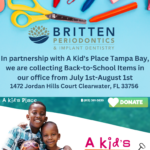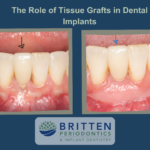Most people have heard of wisdom teeth that become impacted, however the upper canines, or eye teeth are the second most common impacted adult teeth. If a canine tooth does not erupt spontaneously, your orthodontist and periodontist or oral surgeon will work together to get these unerupted canine to erupt. Each case must be evaluated on an individual basis but treatment will usually involve a combined effort. The most common scenario will call for the orthodontist to place braces on the teeth (at least the upper arch). A space will be opened to provide room for the impacted tooth to be moved into its proper position in the dental arch. If the baby canine has not fallen out already, it is usually left in place until the space for the adult canine is ready. Once the space is ready, the orthodontist will refer the patient to the oral surgeon to have the impacted canine exposed and bracketed.
In a simple surgical procedure performed in the surgeon’s office, the gum on top of the impacted tooth will be lifted up to expose the hidden tooth underneath. If there is a baby tooth present, it will be removed at the same time. Once the tooth is exposed, your oral surgeon or periodontist will bond an orthodontic bracket to the exposed tooth. The bracket will have a miniature gold chain attached to it. The surgeon will guide the chain back to the orthodontic arch wire where it will be temporarily attached. Sometimes the surgeon will leave the exposed impacted tooth completely uncovered by suturing the gum up high above the tooth or making a window in the gum covering the tooth (on selected cases located on the roof of the mouth). Most of the time, the gum will be returned to its original location and sutured back with only the chain remaining visible as it exits a small hole in the gum.
Shortly after surgery (1-14 days) the patient will return to the orthodontist. A rubber band will be attached to the chain to put a light eruptive pulling force on the impacted tooth. This will begin the process of moving the tooth into its proper place in the dental arch. This is a carefully controlled, slow process that may take up to a full year to complete. Remember, the goal is to erupt the impacted tooth and not to extract it! Once the tooth is moved into the arch in its final position, the gum around it will be evaluated to make sure it is sufficiently strong and healthy to last for a lifetime of chewing and tooth brushing. In some circumstances, especially those where the tooth had to be moved a long distance, there may be some minor gum surgery required to add bulk to the gum tissue over the relocated tooth so it remains healthy during normal function. Your dentist or orthodontist will explain this situation to you if it applies to your specific situation.
Dr. Britten works with excellent pediatric dentists, general dentists and orthodontists in our area to surgically intervene in case of an impacted tooth. Call us today if you have any questions! 727-586-2681.




